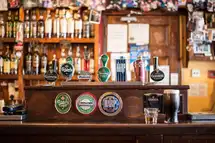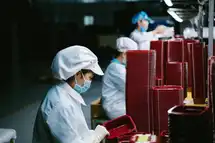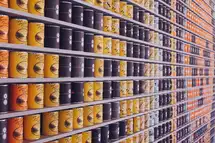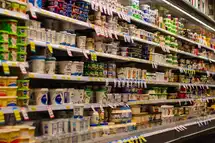What is a restaurant supply chain?
A restaurant supply chain is a network of suppliers that provide the necessary ingredients and supplies to restaurants. The supply chain typically includes farmers, food manufacturers, distributors, and retailers.
5 Common Problems That Plague the Restaurant Supply Chain (Plus Their Solutions)
How Does a Restaurant Supply Chain Function?
There's an exquisite new cafe in town. It advertises its menu. A decadent salad selection. Artisanal sandwiches. Handmade pastas. Plant-based milks. A variety of sustainable meats and locally sourced greens. The cafe's USP is farm-fresh, healthy, and nourishing ingredients and its menu features a mind-boggling array of these wholesome ingredients. The advertising alone makes you hungry.
This ad isn't alone. There are thousands of restaurants hawking their wares through mouth-watering sales pitches. But there's often a slip between the cup and the lip. For a restaurant to deliver the goods, it has to have a first-rate, reliable restaurant supply chain management. Without it, the restaurant will have to eat its own words.
If your supply chain management isn't efficient, and bottlenecks affect the delivery of your ingredients and equipment, the operations, customer service, and quality of food at your restaurant will deteriorate. One of the most important strands of running a restaurant successfully has been and always will be effective and efficient supply chain management.
The restaurant supply chain is both a network and a string of processes that start with procuring raw materials and ingredients, and end with customers served food. The soil-to-sale process is long and risky, especially because food items are perishable. Therefore, each step in the process must be monitored, manually or with the help of tools, with extreme diligence to make sure no contamination, decay, or spoilage occurs.
There are many links in this chain -- from purchasing raw materials, transporting, processing, packaging, and delivering them. It's also important to understand that each step can have a ripple effect on the next. That's why it's important to streamline the entire process. Any inefficiency can send the system off the rails.
Following each step with precision results in good restaurant service. This is why it's important for restaurants to establish a good relationship with their suppliers and distributors in order to maintain the standard of their menu and win customer satisfaction.
How Does a Smooth Supply Chain Impact a Business?
The primary goal of an efficient supply chain process is to recognize business demands and ensure that every item reaches its destination on time and meets quality standards and safety protocols. But there are many other boxes a good supply chain should check-
- The prerequisite in any food and beverage business is to follow all the federal food safety guidelines at every step before the final product delivery is made to a customer. A well-regulated supply chain system streamlines every process to ensure the guidelines are met and the food finally delivered is safe and contamination-free.
- The supply chain also helps in preventative control measures by ensuring that food service facilities identify physical and bacterial hazards to food and take adequate measures to mitigate risks.
- The supply chain ensures that scientific standards are followed to grow, harvest, package, and hold food products.
- Every supply chain follows the Foreign Supplier Verification Program to make sure that international suppliers comply with federal regulations.
- Efficient supply chain solutions use temperature monitoring systems enabled by new technologies. For instance, Radio Frequency Identification (RFID) -- a technology for data collection -- helps identify the quality of food items through low-power radio waves.
- A well-implemented supply chain solution also helps a business manage its inventory efficiently by ensuring that stock-outs or over-stocking doesn't happen.
- It helps businesses reduce food costs that may occur due to food wastage and increases the profitability ratio.
- If implemented effectively, supply chain solutions can streamline procuring, delivery, and thus customer satisfaction.
- The best supply chain solutions also integrate with a business's other technologies to provide data-backed reports. These reports can help business managers improve the back end and serve customers better.
An efficient supply chain is the backbone of a business.
How can you ensure it's doesn't buckle and hurt your restaurant?
Supply Chain Problem No. 1 - Rising Costs
After more than two years of slowdown in the supply chain, a drop in coronavirus infections meant more restaurants -- whether franchised QSRs, full-service or fast casual diners -- started reopening to full capacity. The current state of the restaurant industry's supply chain is full of challenges. There is high demand, which has caused shipping costs to increase and ports to become clogged. It difficult to obtain fuel and labor has become scarce. As a result, food prices have increased, and there's a shortage of several key ingredients, including cooking oil (sunflower and canola), chicken, and corn. In early 2022, the International Monetary Fund reported that shipments were delayed by nearly three weeks at the Port of Los Angeles. Other U.S. ports have also been experiencing significant delays.
The disruption is becoming a major challenge to operators. In addition, tensions in Eastern Europe related to the Ukraine War have put additional pressure on supplies by disrupting the agricultural sector and halting important imports of fertilizer and energy resources required for running food supply chains and the agricultural sector smoothly.
Hudson Riehle, senior vice president, research, at the National Restaurant Association believes that 2022 will remain another year of transition for the food and beverage industry, with increased volatility, uncertainty, and price-rise.
The best way to deal with rising costs in the supply chain is through careful and constant monitoring. In addition, a business can keep its costs down by executing its plans efficiently and improving warehouse efficiency.
At the recent National Restaurant Association annual conference, Brian Warrener, an associate professor of food and beverage management at Johnson and Wales University, said that incorporating technology is the best way to deal with rising costs.
Technology is always updating, and with these updates come new ways to improve the way businesses are run. For example, a restaurant will suffer high costs due to over-ordering or employees taking too long to complete certain tasks. But Warrener believes that if a restaurant can find and implement new ordering and payment technologies, they can cut down on about 25% of the work their employees do. This saves the business money and frees up employees to do other tasks. He added that menu management must be flexible. Changing menus frequently -- in tune with altering stock prices and availability -- can help businesses cut costs.
Supply Chain Problem No. 2 - Lack of Coordination with Suppliers
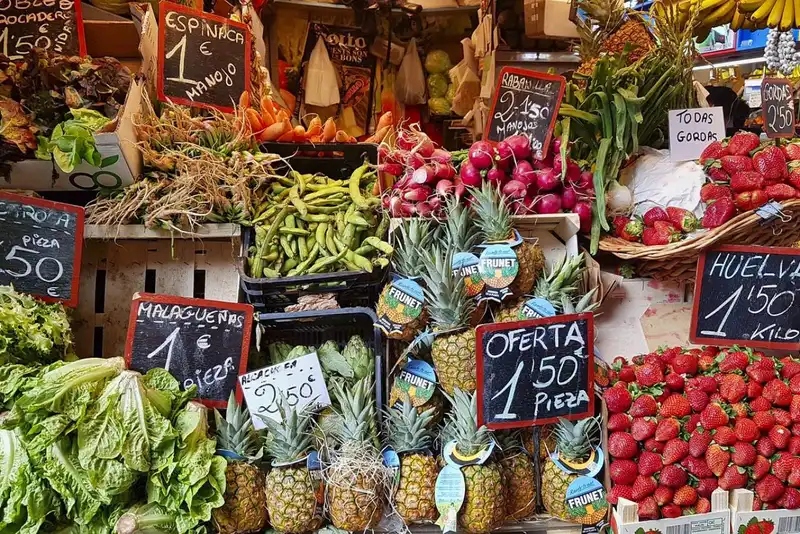
Lack of coordination, known in the supply chain domain as the bullwhip effect, occurs when small demand fluctuations at the retail level cause larger fluctuations upstream in the supply chain. The effect is named after the physics of cracking a whip, which involves a similar amplification of movement.
Let's understand this with an example- say, the sale of french fries at your restaurant has suddenly spiked. To avoid stock-out during the upcoming long weekend, you purchase 50,000 ounces of frozen fries. Looking at the increased demand, your supplier also increases their frozen-fried stock. But it can lead to a domino effect. If the sale isn't as expected, everyone will suffer losses.
To manage demand and supply as efficiently as possible, stakeholders throughout the supply chain must coordinate with each other. Good visibility of actual demand is crucial at every stage of the supply chain, from consumers to the upstream chain. Sharing information is a key part of gaining visibility. Synchronization greatly affects every part of the chain, including manufacturing, procurement, distribution, and delivery to customers. Companies with a collaborative approach increase visibility across the network, which minimizes inconsistency.
An automated system like Zip Ordering (from the restaurant management software suite, Hubworks) can help a business efficiently monitor its orders with different suppliers. Such systems regulate the budget, reduce the risk of overspending, and allow managers to see the number of orders placed compared to the total sales in real time. It also lets one view the details of every supplier the business orders from, manage different sales channels, and monitor the total value of all weekly orders.
Supply Chain Problem No. 3 - Spoilage of Products
When it comes to the global food supply chain, food spoilage is a major problem. Recent reports suggest that one-third of all food globally produced is wasted or lost, amounting to approximately $35 billion annually. Many food losses are due to ineffective cold chain processes and management. As food moves through various stages of the cold chain, it becomes more difficult to maintain produce at ideal conditions. In addition, each stage can lead to potential changes in conditions, which can greatly reduce the shelf-life of the produce.
For instance, vegetables and fruits need to be treated with care if you want them to stay fresh. Even raw meat must be properly packaged to reduce the risk of contamination and bacterial growth. Fruits and vegetables are especially temperature-sensitive and make up around half of food waste. Bad storage conditions like a broken fridge or a transportation truck with scarce or uneven power supply can compromise the quality and safety of these perishable products.
That is why it's important to follow proper food safety measures at every stage of the restaurant supply chain process. Integrating food safety software into your business's supply chain solution can greatly help. New-age food safety software, like Zip HACCP, is cloud-based and can generate real-time reports that make it easy for a user to track the different conditions under which the food items are being packed, transported, and processed. It helps avoid food spoilage through constant monitoring.
You want to make sure your new restaurant doesn't run into supply chain problems.
It pays to know what to expect and prepare for it in advance.
Supply Chain Problem No. 4 - Poorly Managed Inventory
Your inventory is a key asset for your business, but can also be a big liability. Too much cash invested in inventory can hurt your business, while not having enough stock to fulfill orders can kill it. Large volumes of inventory can also eat into your profits. Most businesses invest around 20-40% of their capital in inventory. Inventory reduction may seem like a difficult proposition, but it is essential if you want to go from poor inventory management to efficient inventory management. It is possible through better demand planning and less reliance on manual inventory management methods.
Taking a stock record from time to time is one of the best ways to obtain better insights into your inventory control problems. This way, you can see what you have on hand, what you need, and where you may have issues with your supplier. For example, if you have a supplier who's frequently late on deliveries or doesn't deliver the full order, this can cause problems for your inventory. Keeping track of these issues with a stock record can help you identify when it's time to change suppliers.
Any business that wants to keep tabs on their inventory, orders, and order fulfillment needs a system to help them manage and monitor all that data. Only then can it optimize and adapt its processes to ensure prompt order-fulfillment. The only catch is that for any system to work effectively, it needs accurate data about the other logistical processes involved. Software solutions like Zip Ordering and Zip Inventory, QuickBooks, or Zoho Inventory are designed to help businesses get a clear picture of their Restaurant Inventory management, locations, and fulfillment processes with data-backed reports. These tools can help businesses make the right corrective decisions at the right time.
Supply Chain Problem No. 5 - Inaccurate Forecasting

Inaccurate sales predictions can lead to an undersupply or oversupply of inventory, which can negatively impact your business. Inaccurate forecasts often stem from misinterpretation of data or lack of accurate information. It can be difficult to create accurate forecasts when teams are unable to interpret data at each stage of the forecasting process.
A solid supply chain forecasting strategy is critical for businesses because it allows them to anticipate future demand. To do this, analysts use historical data to understand how much product has been ordered in the past in order to predict future needs. This is valuable because it helps businesses plan for potential disruptions that could occur.
By having a methodical supply chain plan, businesses can not only weather disruptions but also manage adverse situations and eventually flourish. By allowing the procurement team to better understand and forecast demand, a well-implemented supply chain solution also improves decision-making. For example, if you integrate a forecasting solution like Zip Forecast into your supply chain operations, it can help you manage your sales forecast effectively. With data-driven demand planning, the software solution enables accurate product planning and service scheduling at every stage.
How can you make sure your restaurant steers clear of the problems that affect supply chains?
This article tells you what to watch out for and shows you how to prevent it.


